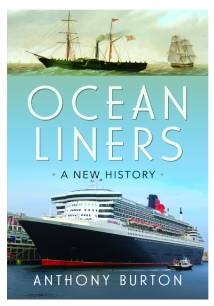Well-researched history of mass maritime travel
Ocean Liners, by Anthony Burton
 There are a lot of books in circulation about historic liners and cruise ships, and many consist mainly of pictures of luxurious first class cabins and opulent ballrooms.
There are a lot of books in circulation about historic liners and cruise ships, and many consist mainly of pictures of luxurious first class cabins and opulent ballrooms.
However, the new title Ocean Liners has a great deal more to it, with plenty of technical content to appeal to an audience of maritime professionals.
The story starts in the 19th century, when the first dedicated passenger liners gradually came into use. Before this, anyone wishing to travel across the oceans for a visit or a new life had to find some kind of berth on a cargo ship.
These new services were being introduced in a period of transition from sail to steam, and at first the passenger and crew accommodation were both pretty basic. Yet, as we learn in the book, purpose-built steam liners such as Isambard Kingdom Brunel's SS Great Britain were constructed with comfort more in mind.
Author Anthony Burton also tells the story of another Brunel liner, the SS Great Eastern. The construction of this vessel was famously challenging, and just as the Great Eastern was about to set off on its 1859 maiden voyage, an engineering mistake led to a build-up in boiler pressure, with disastrous results. Burton quotes the following report from The Times, which had a correspondent onboard:
'The forward part of the deck appeared to spring like a mine, blowing the funnel up into the air. There was a confused roar amid which came the awful crash of timber and iron mingled together in frightful uproar and then all was hidden in a rush of steam. Blinded and almost stunned by the overwhelming concussion, those on the bridge stood motionless in the white vapour till they were reminded of the necessity of seeking shelter by the shower of wreck – glass, gilt work, saloon ornaments and pieces of wood which began to fall like rain in all directions.'
High-quality source materials like this greatly enhance the book, which also features an image of the Great Britain from 1843 that is thought to be the first photograph ever taken of any ship.
Ocean Liners goes on to take its story into the 20th century from different perspectives, including chapters focusing on crew, passengers and safety. The rise of affordable air travel led to the end of most scheduled liner services, but many vessels were repurposed as cruise ships, so the grand tradition of these mighty passenger ships lives on.
This book is the Nautilus Book of the Month for January 2025, and will be sold at a discount in the Nautilus Bookshop throughout the month
Ocean Liners: A New History
By Anthony Burton
Pen & Sword, £30
ISBN: 978 13990 49795
Buy this book in the Nautilus Bookshop
While you're there, why not browse the rest of the titles in our unique maritime bookshop, which sells all the books reviewed on these pages.
Buy nowMore Books
The precarious path from piracy to prosperity
The Resurrected Pirate, by Craig S ChapmanThe Resurrected Pirate is a remarkable story told in an engaging way, illustrating for the modern reader the desperately narrow passage between life and death that a seafarer in this period might have to navigate.
Carving out a career
Ships' Figureheads: Famous Carving FamiliesThe decoration of ships with figureheads was a way to present the might of military and mercantile power for centuries. These days, the skills needed to make these sculptures are kept alive by experts such as Andrew Peters, who has worked on restoration projects such as the Cutty Sark tea clipper.
Knotty problems solved
The Knot Bible: The Complete Guide to Knots And Their Uses by Nic ComptonKnot-tying is a vital competency skill for seafarers, and this expanded edition of The Knot Bible by Nic Compton offers guidance on over 200 knots and their practical uses.
Why it's nice to splice
Splicing modern ropes, 2nd edition: a practical handbook by Jan-Willem PolmanSplicing rope is as an essential skill for seafarers as tying a knot, but some skills are disappearing. This definitive guide on why splicing gets more from your rope is a great stocking filler for all boaters, whether recreational or commercial.
